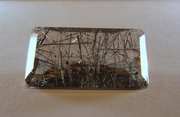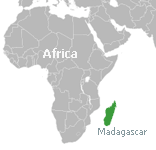At 587,041 km2 (226,657.8 sq mi), Madagascar is the world's 46th-largest country and the fourth largest island. It is slightly bigger than France, and is one of 11 distinct physiographic provinces of the South African Platform physiographic division.
Towards the east, a steep escarpment leads from the central highlands down into a ribbon of rain forest with a narrow coastal further east. The Canal des Pangalanes is a chain of natural and man-made lakes connected by canals that runs parallel to the east coast for some 460 km (about two-thirds of the island). The descent from the central highlands toward the west is more gradual, with remnants of deciduous forest and savanna-like plains (which in the south and southwest, are quite dry and host spiny desert and baobabs). On the west coast are many protected harbours, but silting is a major problem caused by sediment from the high levels of erosion inland.
Along the crest of this ridge lie the central highlands, a plateau region ranging in altitude from 2,450 to 4,400 ft (750 to 1350m) above sea level. The central highlands are characterised by terraced, rice-growing valleys lying between barren hills. Here, the red laterite soil that covers much of the island has been exposed by erosion, showing clearly why the country is often referred to as the "Red Island".
The island's highest peak, Maromokotro, at 2,876 m (9,436 ft), is found in the Tsaratanana Massif, located in the far north of the country. The Ankaratra Massif is in the central area south of the capital Antananarivo and hosts the third highest mountain on the island, Tsiafajavona, with an altitude of 2,642 m (8,668 ft). Further south is the Andringitra massif which has several peaks over 2400 m (about 8,000 ft) including the second and fourth highest peaks, Pic Imarivolanitra, more widely known as Pic Boby (8,720 ft, 2,658 m), and Pic Bory (8,626 ft, 2,630 m). Other peaks in the massif include Pic Soaindra (8,594 ft, 2,620 m) and Pic Ivangomena (8,385 ft, 2,556 m). This massif also contains the Andringitra Reserve. On very rare occasions, this region experiences snow in winter due to its high altitude.
There are two seasons: a hot, rainy season from November to April, and a cooler, dry season from May to October. South-eastern trade winds predominate, and the island occasionally experiences cyclones.




